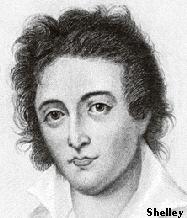

1) In general, to whom is the poem addressed?
2) What kind of change in tone or meaning is signalled by the "but"
beginning line nine?
3) Vocabulary: untrimmed, line 8.
4) Vocabulary: ow'st This is a contraction for ownest, which might make it easier
to find.
5) How would the speaker answer the question he poses in the first line? Why
does he think this comparison would/would not work?
1) How is the lover better than a summer's day?
2) What effect does the spondee in line three have? Why do you think Shakespeare
chose not to use iambic there?
3) What does the final couplet have to say about the relationship between life
and art? Do you think that the final couplet changes the focus of the poem at
all?
4) What syllables are stressed in the final line of the poem? How do those stressed
syllables reinforce the meanings of the line? In other words, how does form
emphasize meaning in this case?
1) Why do you think Hart did not use the sonnet form? Do you think there is
any significance in the fact that his version of the poem has 13 lines?
2) What kind of rhyme scheme does the poem have? How does the rhyme and rhythm
of the poem effect the tone of the poem?
3) What is the speaker's tone?
4) Vocabulary: What are "dog days" (line 1)? How do you think this
choice of words adds to the humor of the poem?
5) Vocabulary: sub-let? What kind of images does this word lend to the poem?
1) How Shakespeare discusses his mistress changes subtly from quatrain to quatrain.
What are some of the differences you can notice?
2) Vocabulary: mistress (line 1)? What is the meaning of the word to Shakespeare
and his contemporaries?
3) Vocabulary: dun (line 3). What image does this word give us?
4) Vocabulary: damasked (line 5). How does this word add to the image?
1) Jot down a description of the mistress based on the images we see in the
poem.
2) What is the speaker thinking? Does he love this woman or not? The final couplet
is telling.
3) Like "Shall I Compare Thee," this poem isn't totally about love.
What is Shakespeare saying about art and artists in this poem?
The Complete Works of PB Shelley: http://www.bartleby.com/139/
The PB Shelley Resource Page: http://www.wam.umd.edu/~djb/shelley/home.html
Romantic Circles: The Shelley Chronology: http://www.rc.umd.edu/cstahmer/shelcron/
The Shelley-Keats House, Rome: http://heritage.virtualsite.co.uk/keats/index2.html
The Temple of Ramses II: http://sangha.net/messengers/Ramses-II.htm
The Walt Whitman Archive: http://www.iath.virginia.edu/whitman/
Walt Whitman, a great site: http://www.liglobal.com/walt/default2.shtml
American Academy of Poets Whitman site: http://www.poets.org/poets/poets.cfm?prmID=127&CFID=14915063&CFTOKEN=10220901